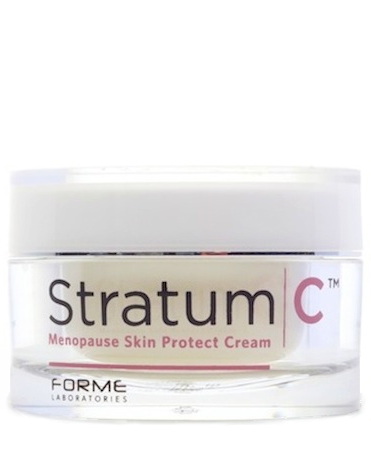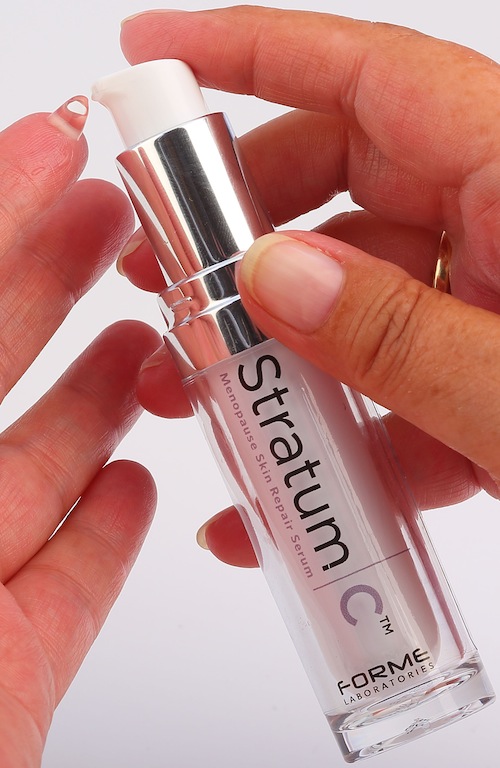The promise of the menopause skin cream – part 2
Do you remember Mikey, the kid who didn’t like anything, except Life cereal? Well, when it comes to menopausal promises, I’m just like Mikey. However, I am going to eat my words this month, words slamming Stratum C and the promise to restore the youthful glow. In October, I shared news about Stratum C, a new cream formulated specifically for menopause skin that had been shown to relax facial muscles AND build collagen, while simultaneously moisturizing, promoting elasticity and providing a radiant glow. After I slammed the manufacturers, they offered to send me a sample with the mutual understanding that I would try it for a month but that I made no promises.
The verdict? I love the way that Stratum C feels going on and I will state unequivocally that in this subject of one, it did appear to soften my lines and improve my skin’s moisture levels and appearance. Whether or not regular use would yield significant, lasting results is beyond my one month test but I will say that I liked it so much, that I’d be inclined to try it for a longer time period. However, I’m sticking by my guns with regard to Stratum C’s ultimate ability to reverse the ravishes of environment and natural aging. And while I will reiterate that there is absolutely no doubt that one of the peptides contained in this new cream and serum stimulates production of collagen (there are published studies demonstrating that), like a majority of dermatologists will tell you, a skin cream alone won’t turn back the signs of time permanently.
Keep in mind that, I only use skin products recommended by my dermatologist (I have rosacea and its accompanying acne issues). But guess what? I’m ready to do some show and tell the next time I visit him.
Hey Forme Laboratories! I like it. And as you’ve come to learn, that’s pretty unusual when it comes to products geared toward menopause.
Read More
The promise of the menopause skin cream
Have you heard about Stratum C? Evidently, this wonder cream, formulated specifically for menopause skin, has been shown to relax facial muscles AND build collagen, while simultaneously moisturizing, promoting elasticity and providing a radiant glow. And, it has science to back it up, you know, an unpublished study conducted in a whopping 10 subjects.
Moreover, as the product restores that youthful glow that menopausal women so crave and erases signs of aging, it will only set you back $195. The thing is, to obtain the best results, evidently you need to use it from the start of menopause symptoms until the last symptom occurs. That’s an average of 10 years.
Want to know what’s in this magical cream?
“In addition to the collagen stimulating peptides Stratum C was formulated to contain Hyaluronic Acid to hydrate and moisturise the skin even into the lower levels of the dermis. Finally to combat existing wrinkles we included a muscle tightening ingredient that has been shown in clinical trials to reduce existing deep wrinkles by 45% in just one month.The base moisturiser in Stratum C is based on natural luxurious products well known to the beauty industry including Jojoba Oil, Seaweed and Apricot Oil the latter being a good source of Vitamin A and E which are also lost during the Menopause.”
In women in particular, aging is accompanied by a loss of estrogen, which has been linked with as great as a 30% loss of collagen in the dermis (the thick, sturdy layer of connective tissue that comprises about 90% of the skin’s thickness) within the first five years of menopause. Collagen, which is the most abundant protein in the body, is responsible for skin’s durability and strength. As it declines, skin starts to sag and wrinkles form. Oh, happy day!
There is absolutely no doubt that one of the peptides contained in this new cream and serum stimulates production of collagen and there are published studies demonstrating that. The question is, however, whether or not a cream or serum contains enough of the ingredient to perform the way that it claims to perform. And quite honestly, a majority of dermatologists will tell you that while a cream can help promote moisture and is necessary, it won’t reverse the ravages of environmental exposure built over the years. Estrogen, for example, has been shown to increase collagen, help the skin retain water and promote elasticity, yet its ability to reverse the effects of aging remain questionable.
I am all for looking as good as we possibly can at any age. A lot of that has to do with genes, sunscreen, diet and prior exposure. And I will be last person to judge someone who wants to drop a bunch of money on the promise of youth. Me? I’d rather save my dollars for something that is proven to work and until that happens, I’ll follow the directions of my dermatologist and preserve what I have got the best I can.
Buyer beware. This one sounds way too good to be true.
Read MoreWednesday Bubble: Better living through chemistry? Your aging skin

Still thinking that hormone replacement therapy (HRT) can improve the appearance of aging skin? You may want to think again.
This past March, dermatologists at the American Academy of Dermatologists’ annual meeting once again debunked claims that HRT can improve the appearance of aging, photo-damaged skin. Although I’ve written on this topic previously, the subject is interesting (and relevant) enough to revisit.
Undoubtedly, certain areas of the body are more receptive to estrogen than others, e.g., cells comprising the skin on the face. And while estrogen can increase collagen, help the skin retain water and promote elasticity, its ability to reverse the effects of aging remain questionable.
Dr. Margaret Parsons, assistance clinical professor of dermatology at the University of California-Davis, says that she does not prescribe estrogen to improve skin’s appearance because data have not consistently shown any benefit. Not only doesn’t she believe that topical or oral estrogens offer any sort of long-term solution, but she also points to the risks involved in their use, such as breast cancer.
Consider the evidence (or lack, thereof):
- In a study published last year in the Journal of the American Academy of Dermatology, researchers evaluated whether or not low-dose HRT could improve the appearance of fine lines and wrinkles, skin dryness/texture and sagging. Study participants were 485 women who had been menopausal for about five years. No significant improvements were seen after 48 weeks of treatment, although researchers suggested that longer use of hormones or different doses might lead to better results.
- In another study, which I wrote about last year, applying topical estrogen to sun-damaged skin, likewise, did not improve the skin’s appearance, although it did appear to promote collagen production in areas that had not seen the light of day, i.e. the hip.
- A third study, published in the early 90s, suggests that use of a topical cream early in menopause and for a longer period of time, may improve the appearance of aging skin. However, this study was only conducted in 18 women over a period of six months, making it difficult to reach any definitive conclusions.
It appears that the jury is still out but deliberations don’t look too promising.
Think about it: are you willing to risk the adverse effects of HRT – cancer, death from lung disease, heart disease – for your appearance?
If you are deadset on erasing a few lines and a few years, there are effective therapies that dermatologist regularly suggest to improve skin’s appearance, for example retinoids, glycolic acid or procedures such as chemical peels, lasers, botox and skin fillers. While they might hit your pocketbook harder than HRT, most do not come with the same degree of health risks. You can learn more about taking care of mature skin in this issue of the American Academy of Dermatology’s SKIN e-newsletter.
Obviously, the best advice is to wear sunscreen regularly, avoid smoking and use a topical retinoid. We may not be able to turn back the clock but we can preserve what we have more responsibly. Estrogen might not be the ounce of prevention that works best.
Read MoreVaginal Atrophy: Is there an effective non-hormonal option?
While the GLAM squad works to convince you that the only sensible option to treat vaginal atrophy is Novo Nordisk’s Vagifem (a topical estrogen agent), I would like to share that a highly effective non-hormonal option exists. The rub? It’s only available in Europe and Canada. The thing is, I have tried it and while I may be an n of 1 in scientific circles, I want to share that it’s pretty darn amazing.
Before I do the reveal, I would like to get a bit personal and share my story. After years of experiencing no issues with vaginal dryness or pain during intercourse, the tables turned this past Summer. And so, I did the most sensible thing that I could do (short of reading Flashfree!); I made an appointment with my gynecologist. And after a thorough examination and a few tests for infections, she recommended that I try Estrace, another topical estrogen in the same category as Vagifem.
If you are a long time reader of Flashfree, you are well aware of how I personally feel about hormones. However, what I’ve not shared on this blog is that I have always had an extreme sensitivity to hormones, a sensitivity that I discovered in my early 20s when I started using the pill. That, coupled with the fact that my mother had breast cancer at an extremely early age made me wary of any type of hormone. And years later, when I started this blog and read all the data I could get my hands on, I was convinced that hormones were not a good route, regardless of their efficacy in addressing menopausal symptoms. Yet, regrettably I chanced it…again.
I want to emphasize that my experience is only mine and is not necessarily reflective of others’. However, within a month of using Estrace, I gained 6 pounds, was bloated, developed severe acne, had daily headaches, and experienced significant and irrational irritability. But damn, my vaginal tissues were once again moist.
Not. Good. Enough.
And so, I started researching my options. And stumbled across Gynatrof. 
Gynatrof gel is a natural topical agent comprised of microscopic beads (known as liposomes) are formulated to act as both a lubricant and a moisturizer. This technology helps to insure that the vaginal tissues remain moist between applications, and additionally, boosts hydration and elasticity. The gel contains several ingredients:
- Hyaluronic acid, a type of molecule found abundantly throughout the body’s connective tissue, the skin and the nervous tissues. Hyaluronic acid has the ability to store large quantities of water, thereby forming a natural, moisturizing liquid film when applied topically. More specifically, it helps to protect the vaginal skin from irritation and redness, itching and burning; enhances natural lubrication and may even help to aid healing of irritated vaginal tissue.
- Hops plant extract, which has weak estrogenic effects and may help promote lubrication and elasticity. Hops have also been shown to possess antibacterial properties and are sometimes used for leg ulcers.
- Vitamin E, which the manufacturer says reduces inflammation and prevents aging of the vaginal area. If anything, vitamin E is believed to be an antioxidant that may help prevent or treat disease. It has also been used for centuries to treat the skin and has been shown to penetrate both the outer and next layer of the skin (epidermis, dermis, respectively).
Available in Europe since 2006, Gynatrof has proven safe and there have been no reports of estrogen-related sensitivity. It is also non-toxic should it be accidentally ingested.
My personal experience? I have been using Gynatrof for a month now. And I have had stellar results – no side effects, no sensitivity and no issues during intercourse.
As someone who regularly colors outside the lines, it’s no surprise that I was able to obtain Gynatrof. But more importantly, when I contacted a local compounding pharmacy to see if they could obtain it for me, they called back after several hours to inform me that they could not.
This is an OTC product in both Europe and in Canada. It has been on the market for eight years now. And yet, we do not have access to it in this country. Moreover, it works, at least for me. And it is a safe option for women who either cannot tolerate hormones or choose not to use them.
Anyone interested in starting a petition? I cannot endorse this product enough.
[Disclosure: I neither contacted the manufacturer or its representatives nor did either contact me to review Gynatrof. It worked so well for me that I wanted to share it with my readers]
Read More
Do women truly need to supplement testosterone levels?
 Testosterone is a hot topic for men. But evidently, it’s an equal opportunity hormone, designed to boost low libido one woman, one cream application at a time. But what is it about testosterone that makes its use in menopausal women questionable if downright unhealthy?
Testosterone is a hot topic for men. But evidently, it’s an equal opportunity hormone, designed to boost low libido one woman, one cream application at a time. But what is it about testosterone that makes its use in menopausal women questionable if downright unhealthy?
The levels, that’s what.
I’ve written about testosterone before and you can look up the archives via this link. The upshot is that for both men and women, testosterone therapy is oversold as a panacea for just about everything from distress about aging to sexual desire to bone, heart and mental health. Wow! Quite the Fountain, no?!
However, while transdermal (through the skin) testosterone is preferable (it avoids metabolism by the liver and promotes steady blood levels of the hormone), the patch has gotten the boot both in this country and overseas, and implants are no longer available. LibiGel, a topical cream was also denied market entry by the FDA. The result has been frequent prescribing of compounded testosterone in both genders.
Mind you, Allopathic practitioners for the most part shun compounded products, claiming safety issues and the lack of regulation. And in some cases, they are absolutely correct (do you recall the New England compounding crisis?). More recently, the North American Menopause Society (NAMS) issued a press release knocking compounded prescriptions, noting that they may deliver excess levels of testosterone thereby “producing untoward effects.” For example, too much testosterone may lead to depression, promote unwanted acne and hair growth, enlarge the clitoris, deepen the voice, produce aggression and boost cholesterol levels. The answer? According to NAMS, the answer may lie in an Australian formulation — AndroFeme — that was recently tested in seven healthy, postmenopausal women.
In a study published ahead of print in the journal Menopause, the researchers report that this 1% testosterone cream, applied 5 mg daily for 21 days and then immediately thereafter, 10 mg daily for 21 days, resulted in peak blood levels of testosterone that were in the normal range; while the 5 mg dose raised blood levels only slightly above normal, the 10 mg dose raised it to a higher level (double the upper limit). Moreover, apparently neither dose level had an impact on estrogen levels or sex-hormone binding globulin, a protein that binds to the sex hormones and determines how much of them remain available.
So, what’s the lowdown? Theoretically, the Australians have arrived at an acceptable testosterone dose for women with a safe delivery system. They report that it was well tolerated but did not qualify what this means. If you read the NAMS press release, the organization is basically promoting a pharmaceutical grade product over compounded agents even though the study was conducted in a mere seven women. Seven women do not a conclusion make…ever.
How much testosterone is too much for women after menopause? As of today, any amount might be too much until more data are available. Buyer, beware. T is for thwart and the time to put low T to bedis now.
Read More







